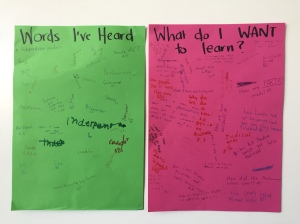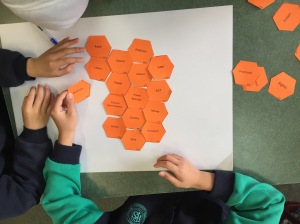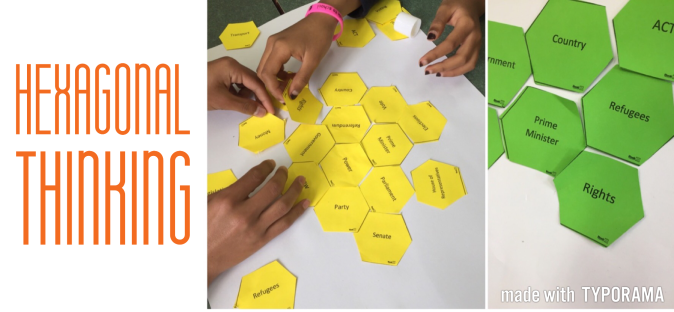Hexagonal Thinking is a visual tool to help people make connections and organise ideas on a topic. I first learned about hexagonal thinking through the No Tosh Lab who encourage the use of it for going from the messy idea stage of the designing thinking process to the stage where ideas are organised and ordered to work towards solutions.
I used hexagonal thinking with my class this week as a tuning in activity for our term inquiry unit “Who’s Got the Power?” which will look at Australian civics and history through the lens of current parliament.
 Previously during the week, to collect pre-assessment and to get student feedback to inform unit design, I had my students list any words they had heard about this topic that they either already knew or did not know. They also listed any questions they had or things they wanted to find out more about.
Previously during the week, to collect pre-assessment and to get student feedback to inform unit design, I had my students list any words they had heard about this topic that they either already knew or did not know. They also listed any questions they had or things they wanted to find out more about.
I used these words and questions to create a list of words to put on the hexagonal cards, and presented small groups with 30 words from their lists, such as government, parliament, laws, refugees, promises, tax, referendum.
The groups worked together to organise and join the word cards by linking words that they thought had strong connections. We talked about strong and weak connections, for example “Governments have lots of money” was a weak link, but “Governments have lots of responsibility because they have to control and spend money for all Australians fairly” was a strong connection, which allowed them to add more words to their honeycomb.

The benefits of this activity were clear:
- Students learned LOTS of new vocabulary (they looked up the meaning of unknown words or learnt it from a peer).
- Learning new concepts from peers was strong (e.g. one student explaining a jury to the rest of her group by referencing a movie).
- It was clear for me to identify areas were students have little or no knowledge to follow up in future lessons.
- The explanations and justification had to be strong for group members to make a case to their group in order to put a card where they thought it should go, otherwise they would be overruled by the group.
- A strong decision-making process was key for groups to be able to work collaboratively on this task.
Resources:
- I made my hexagonal cards on Pam Hook’s HookEd website.
- She also has blank templates for printing here.
- There is a hexagonal thinking generator in ClassTools that could allow groups to work on this in a digital space instead. I did not find the Word Doc download to work on this site.

Great write up thanks! I just discovered hexagonal thinking today on Twitter and this was very helpful to explain how it works.
LikeLike
Thanks for reading David. Would love to know how you use it, it’s good to see examples in action!
LikeLike
Thanks for such a clear explanation of hexagonal thinking. I will give it a try in my lesson plans.
LikeLike
Thanks Matt! I would love to hear how it goes when you use it. It’s good to see other people’s examples.
LikeLike
Have you used Hexagonal Thinking in mathematics? Interested to see an example.
Regards
Ellen
LikeLike
Hi Ellen,
I have used it a couple of times in maths. We always start our units with getting familiar with vocab so we used the same process for introducing words for maths units.
Let me know if you try it and how you get on!
Emily
LikeLike
Thank you for the explanation. I read about this method from The Really Lazy Teacher’s handbook but I needed someone’s example doing this and I found you!
LikeLike
I love blogs because they’re full of examples of theory into practise. I hope hexagonal thinking goes well for you – I use it so often now because I think it’s so powerful!
LikeLike